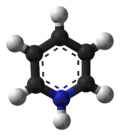Pyridinium
| |||
| Names | |||
|---|---|---|---|
| Preferred IUPAC name
Pyridin-1-ium | |||
| Identifiers | |||
3D model (
JSmol ) |
|||
| ChemSpider | |||
PubChem CID
|
|||
| UNII | |||
CompTox Dashboard (EPA)
|
|||
| |||
| |||
| Properties | |||
| [C5H5NH]+ | |||
| Molar mass | 80.110 g·mol−1 | ||
| Acidity (pKa) | ~5 [1][2] | ||
Conjugate base
|
Pyridine | ||
Except where otherwise noted, data are given for materials in their standard state (at 25 °C [77 °F], 100 kPa).
| |||
Pyridinium refers to the
conjugate acid of pyridine. Many related cations are known involving substituted pyridines, e.g. picolines, lutidines, collidines. They are prepared by treating pyridine with acids.[3]
As pyridine is often used as an
insoluble in the organic solvent, so precipitation
of the pyridinium leaving group complex is an indication of the progress of the reaction.
Pyridinium cations are
isoelectronic with benzene
.
N-Alkylpyridinium cations

When the acidic proton is replaced by
alkyl, the compounds are called N-alkylpyridinium. A simple representative is N-methylpyridinium ([C5H5NCH3]+). These pyridinium intermediates have been used as electrophiles in synthetic organic chemistry to build dearomatized congeners called dihydropyridines, as demonstrated in one example from Smith in 2021.[5] Earlier, the same research group also delineated the rules surrounding regioselectivities associated with adding nucleophiles to pyridinium electrophiles with varying substituents.[6] From a commercial perspective, an important pyridinium compound is the herbicide paraquat.[7]
See also
References
- .
- .
- .
- ^ "Aromatic Compounds" (PDF). Alex Roche, Rutgers University.
- S2CID 237401193.
- S2CID 231945207.
- ISBN 978-3527306732.


